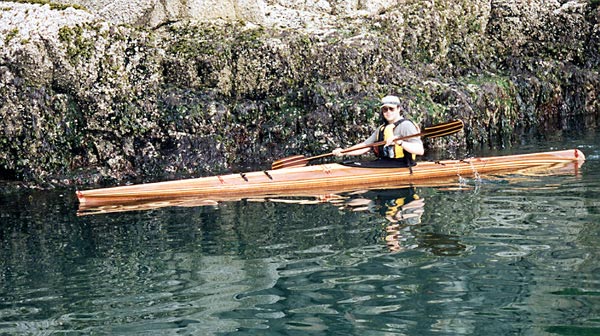












Product Description
This strip-planked kayak is a modification of the skin-on-frame Aleut baidarka kayaks. Baidarkas are legendary for their speed and seaworthiness, however much of the performance attributed to baidarkas may have been due to their flexible frame. In converting to the strip-built construction method, the performance characteristics are inevitably going to change.
Since performance differences were inevitable, designer Nick Schade decided it made sense to modify the traditional baidarka shape to take advantage of the possibilities of the strip building method. The result is this Aleut-like or ‘Aleutesque’ kayak design.
Much has been written about the split bow of the traditional baidarka. There has been speculation that it acts like a bulbous bow as seen on supertankers or that it is a totem symbolising a salmon jaw. The theory that was most interesting to Schade was that it served to create a clean entry at water level, but provided reserve buoyancy above the waterline to help ride over waves. In a skin-on-frame boat it is hard to pull the fabric into a hollow shape: the easiest way is to cut down the seam and sew the two sides completely together. Since strip building does not have the waterproofing issue, Schade did not think the difficult-to-make open jaws were necessary, so he merged the upper and lower jaw into one continuous piece.
Baidarkas also have a very interesting stern shape. One of the interesting theories was it acted like a transom which improved surfing characteristics and overall speed. Nick Schade decided to see what would happen if the boat had a real transom, but still reminiscent of the traditional baidarka stern.
The result is a fast boat that will attract a lot of attention. Due to the relatively low volume of the boat, this is probably not the best boat for a lot of rough water use but it is a fast surfing boat that responds easily to steering strokes. With a small permanent external skeg it is well balanced in cross winds where its narrow beam lets it ride over side waves with good control. The fit in this boat is tight and the low deck (less than 11″ at the front of the cockpit) does not leave a lot of room for feet. The boat rolls very nicely with the low back deck making lay-back style rolls comfortable.
This boat is not for novices. It is a tricky boat to build and it takes practice to get the most out of it on the water. It's narrow waterline width makes it quite twitchy especially during entry and exit but, once seated, the stability increases substantially. There are several difficult sections in the building of the kayak and it is not recommended as a first kayak building project unless you are confident in your woodworking skills. While the boat is not easy to build or paddle, the effort will be rewarded with a beautiful kayak that comes alive on the water.
The kit includes:
- Pre-cut forms and strongback
- Spruce blanks for bow and stern
- A mixture of red cedar strips and paulownia strips with bead-and-cove joints
- Waterproof glue for the wooden strips
- Epoxy resin and activator
- Epoxy fillers
- Woven glass fabric
- Fabric covered foam seat and backband
- Adjustable footbraces
- Foam knee pads
- Deck hold-down lines (bolt-on)
- Plans and building notes
- The Strip-Built Sea Kayak (book) by Nick Schade
- Free technical support from a competent builder
We supply roughly one-third red cedar strips and two-thirds Paulownia strips as standard but if you have a particular pattern in mind, we can provide a different ratio if you contact us before ordering. We can also supply yellow cedar strips.
Plans (not required by kit purchasers)
The plans contain sufficient information to make it possible to build the boat from scratch rather than a kit. They include full size drawings for all the forms. We recommend Nick Schade's book, The Strip-Built Sea Kayak, which covers the techniques that are used to build strip-planked kayaks.
Forms and strongback
For those wanting to obtain the other materials needed to build the boat from other sources, this option contains the pre-cut forms and strongback and the necessary plans to build the boat. The wooden strips are not included (see below).
Wooden strips
As well as the forms and strongback, 435 m of bead-and-cove cedar strips and/or paulownia strips will be needed.






